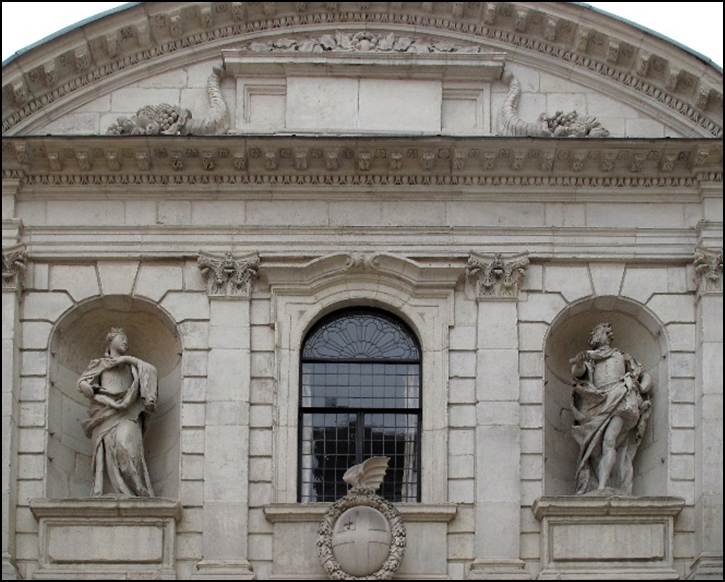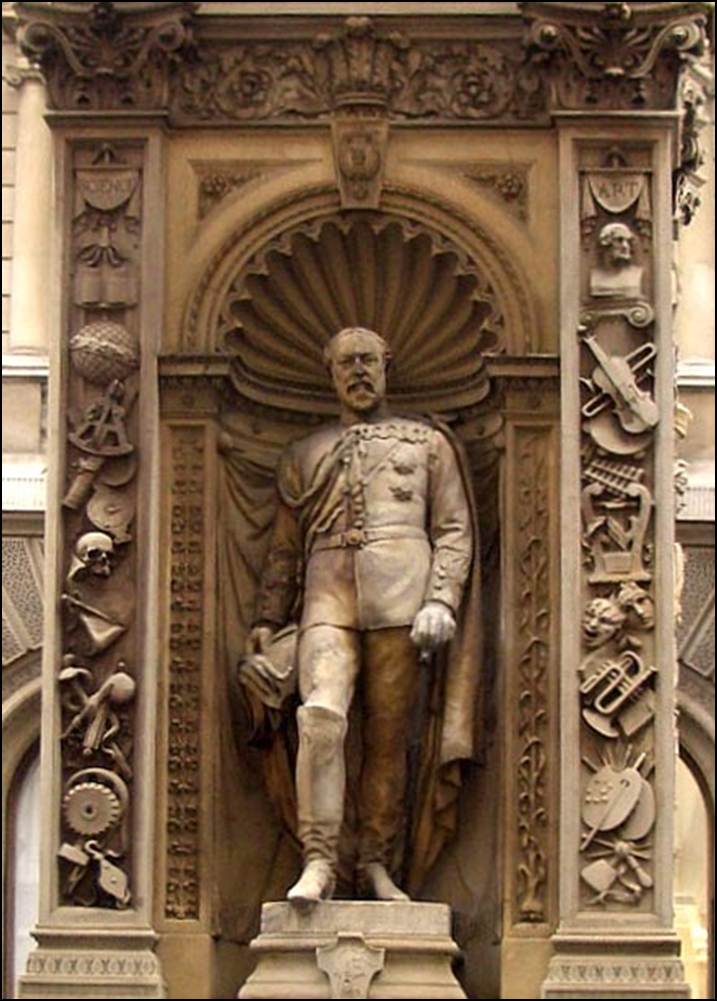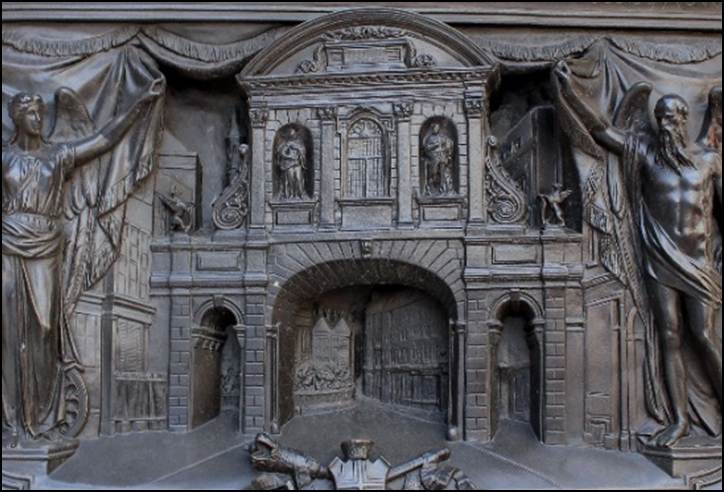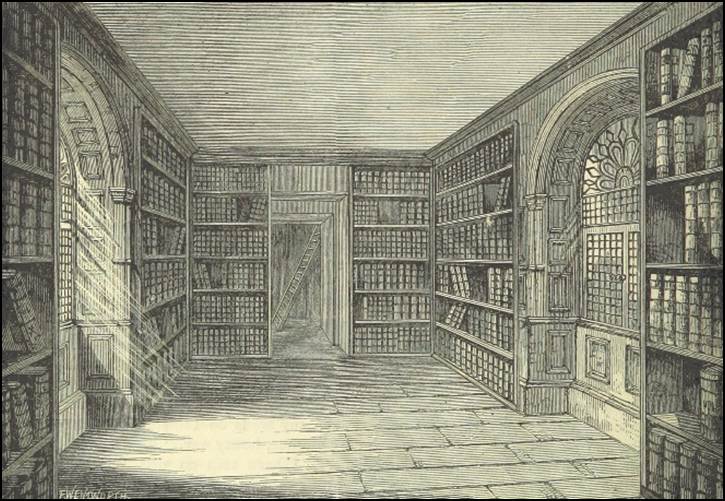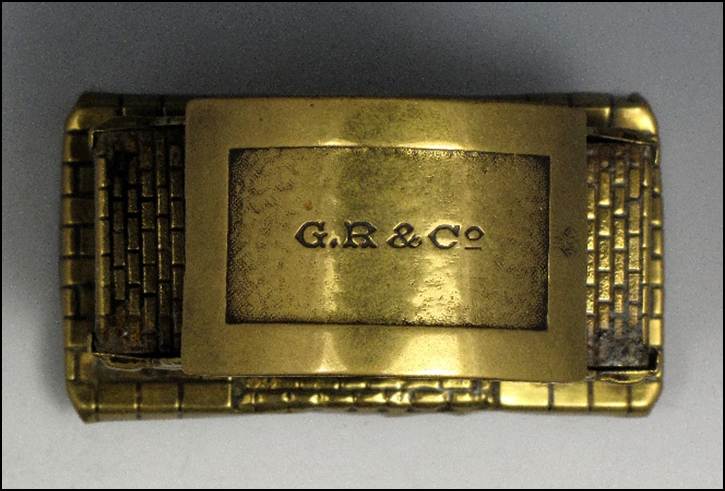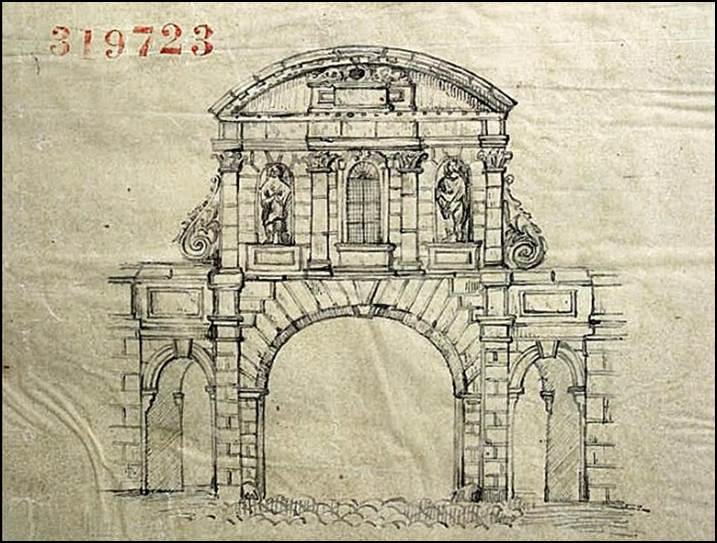G.
R. & Co. History
 (Note: Unfortunately, no
information about the firm known as G. R. & Co. has been found because no
business with those initials has been located.
It is assumed that this company was originally from the London area
because other than the W. Avery & Son, Redditch name, who registered the
Temple Bar needle case design in 1878, all of the other companies with their
names stamped on this needle case were located in London. Also, because the Temple Bar is a well-known building
with great significance in the London area, it makes more sense that London
companies would be more interested in having their names stamped on it. A search was done on Google, Google Books.
Ancestry.com and other websites to see if a company with this name existed in
London or Birmingham but nothing was found.
Yes, there were several companies with the initials G. R. followed by a
surname and then the word Co. One would
think if this company wanted to abbreviate its name so it could possibly fit better
on top of the Temple Bar needle case, they would have used the initials of the
forename and surname, not the forename and middle name. Therefore, the focus of this chapter will be
on the history of the Temple Bar rather than of G. R. & Co. because the
Temple Bar has an interesting past that goes back centuries.)
(Note: Unfortunately, no
information about the firm known as G. R. & Co. has been found because no
business with those initials has been located.
It is assumed that this company was originally from the London area
because other than the W. Avery & Son, Redditch name, who registered the
Temple Bar needle case design in 1878, all of the other companies with their
names stamped on this needle case were located in London. Also, because the Temple Bar is a well-known building
with great significance in the London area, it makes more sense that London
companies would be more interested in having their names stamped on it. A search was done on Google, Google Books.
Ancestry.com and other websites to see if a company with this name existed in
London or Birmingham but nothing was found.
Yes, there were several companies with the initials G. R. followed by a
surname and then the word Co. One would
think if this company wanted to abbreviate its name so it could possibly fit better
on top of the Temple Bar needle case, they would have used the initials of the
forename and surname, not the forename and middle name. Therefore, the focus of this chapter will be
on the history of the Temple Bar rather than of G. R. & Co. because the
Temple Bar has an interesting past that goes back centuries.)
Temple
Bar History[1]
 During the Middle Ages the City of
London erected barriers or gates which they called bars on major entrance
routes connecting the City of London with other areas. This was done to regulate trade into the
city. The one constructed in the Temple
precinct, named after the Temple Church and Temple Courts, became known as the
Temple Bar. This gate was on the main
road into the City of London from the City of Westminster. It was located at the intersection of The
Strand, a street in Westminster, and Fleet Street in the City of London. This route was one of the busiest roads
because it went from the Tower of London to the Palace of Westminster. At first the gate was probably only a chain or
bar between a row of posts. The original
Temple Bar was a wooden building constructed by the year 1351 as seen in the
artwork pictured here[2].
During the Middle Ages the City of
London erected barriers or gates which they called bars on major entrance
routes connecting the City of London with other areas. This was done to regulate trade into the
city. The one constructed in the Temple
precinct, named after the Temple Church and Temple Courts, became known as the
Temple Bar. This gate was on the main
road into the City of London from the City of Westminster. It was located at the intersection of The
Strand, a street in Westminster, and Fleet Street in the City of London. This route was one of the busiest roads
because it went from the Tower of London to the Palace of Westminster. At first the gate was probably only a chain or
bar between a row of posts. The original
Temple Bar was a wooden building constructed by the year 1351 as seen in the
artwork pictured here[2].
Although the Temple Bar was not
damaged during the Great Fire of London in 1666, city officials decided a new
gate was needed. The famous architect
Sir Christopher Wren, who also designed St. Paul’s Cathedral and a number of
other buildings after the fire, was selected to design the new Temple Bar. It was made of Portland stone and was
constructed between 1669 and 1673. The
building, as seen in this 1854[3]
work of art, consisted of tw o stories with a wide central arch on the ground
level to be used for road traffic and two narrow side arches for
pedestrians. The top part contained a
room with an arched central window and two small arched area on the sides where
statues were placed. On one side the
statues were of King Charles II, who was the King of England, Scotland and
Ireland at the time the building was built, and his father King Charles I. On the other side the statues were of King
James I and Anne of Denmark, the parents of King Charles I. The Temple Bar remained at this location for
two centuries. Then in 1874 it was
discovered that some of the stones were out of place and the ground floor
arches had to be supported with wooden beams.
In addition, horse and cart traffic had increased substantially over the
years preventing some trade from entering the city. A decision was made to dismantle the
building in 1878. Two years later in
1880 a brewer named Henry Meuz purchased the building’s stones and it was
re-erected at his mansion in Theobalds Park, Hertfordshire, about 19 miles
northwest of central London. The news of
the dismantling must have reached the Redditch area and could be the reason W.
Avery & Son registered his design for a
Temple Bar needle case in 1878.
Some versions of this needle case have the inscription “Erected 1670
Removed 1878” stamped on the base.
o stories with a wide central arch on the ground
level to be used for road traffic and two narrow side arches for
pedestrians. The top part contained a
room with an arched central window and two small arched area on the sides where
statues were placed. On one side the
statues were of King Charles II, who was the King of England, Scotland and
Ireland at the time the building was built, and his father King Charles I. On the other side the statues were of King
James I and Anne of Denmark, the parents of King Charles I. The Temple Bar remained at this location for
two centuries. Then in 1874 it was
discovered that some of the stones were out of place and the ground floor
arches had to be supported with wooden beams.
In addition, horse and cart traffic had increased substantially over the
years preventing some trade from entering the city. A decision was made to dismantle the
building in 1878. Two years later in
1880 a brewer named Henry Meuz purchased the building’s stones and it was
re-erected at his mansion in Theobalds Park, Hertfordshire, about 19 miles
northwest of central London. The news of
the dismantling must have reached the Redditch area and could be the reason W.
Avery & Son registered his design for a
Temple Bar needle case in 1878.
Some versions of this needle case have the inscription “Erected 1670
Removed 1878” stamped on the base.

Temple
Bar Today
The Temple Bar remained in Theobalds Park
for over 100 years. Then in 1984 it was
purchased by the Temple Bar Trust for £1 and was re-erected in 2004 at Paternoster Square just north of
St. Paul’s Cathedral at a cost over £3
million. The Temple Bar today is a
popular tourist destination in London because of its location next to St.
Paul’s. The photograph seen here is of
the south side of the building facing the cathedral. Additional photographs can be found in the
Images section.
Temple
Bar Memorial
 After the removal of the Temple Bar
from its original Fleet Street/The Strand location, a Temple Bar Memorial was
built in its place in 1880. This
memorial stands in the middle of the street in front of the Royal Courts of
Justice (pictured on the left) which were built from 1873-1882 o
After the removal of the Temple Bar
from its original Fleet Street/The Strand location, a Temple Bar Memorial was
built in its place in 1880. This
memorial stands in the middle of the street in front of the Royal Courts of
Justice (pictured on the left) which were built from 1873-1882 o n the north
side of the street. The memorial
(pictured on the right) consists of an elaborate pedestal with statues of Queen
Victoria and her son, Edward VII the Prince of Wales, on the sides with a
dragon statue, the symbol of the city of London, on the top. The statues of the Queen and her son were
added because they were the last Royals to walk through the original Temple Bar
in 1872 before it was moved. Along the
sides are other sculptures and metal work including
the artworks known as “Time and Fortune Draw a Curtain Over Temple Bar” (pictured
below n
the left) and “Queen Victoria’s Progress to the Guildhall Nov.
9th, 1837” (pictured below on the right).
n the north
side of the street. The memorial
(pictured on the right) consists of an elaborate pedestal with statues of Queen
Victoria and her son, Edward VII the Prince of Wales, on the sides with a
dragon statue, the symbol of the city of London, on the top. The statues of the Queen and her son were
added because they were the last Royals to walk through the original Temple Bar
in 1872 before it was moved. Along the
sides are other sculptures and metal work including
the artworks known as “Time and Fortune Draw a Curtain Over Temple Bar” (pictured
below n
the left) and “Queen Victoria’s Progress to the Guildhall Nov.
9th, 1837” (pictured below on the right).






